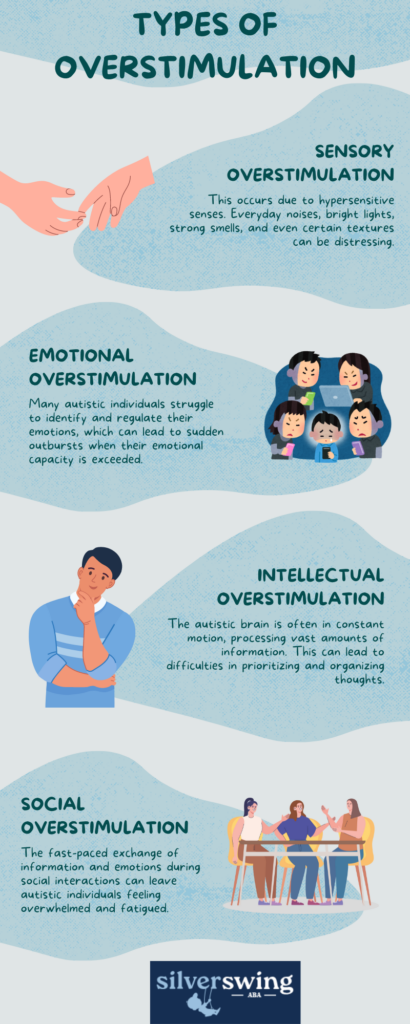For parents and caregivers of autistic children, witnessing a meltdown can be a challenging and distressing experience. It’s crucial to understand that these meltdowns are not mere tantrums seeking attention or rewards but are often the result of sensory overload.
When an autistic child is bombarded with excessive stimuli, their brain’s filtering system, which may already be compromised, struggles to manage the input. This condition may lead to an overwhelming need to escape or regain control.
The Connection Between Autism and Sensory Overload
Almost all children on the spectrum exhibit some form of sensory issue. This has prompted researchers to delve deeper into the brain mechanics behind why autistic individuals find the world so overwhelming. Understanding sensory overload in autism can help in developing better interventions and accommodations to make life more manageable for those affected.
Sensory overload occurs when there is “too much” of certain external stimuli for the brain to process effectively. This can result in feelings of being overwhelmed and the impulse to escape the stimuli, which may manifest as crying, screaming, or physical thrashing. Sensory overload is essentially a form of pain, and its triggers can vary widely among autistic individuals.
Several theories explain why autistic individuals are prone to sensory overload. One key factor is ‘habituation’, the process by which the brain reduces its response to repeated stimuli. Studies suggest that autistic children may have a weakened ability to habituate to stimuli, meaning their brains do not filter out familiar information as effectively as neurotypical brains do.
Additionally, many autistic individuals experience sensory processing disorder, where the brain has trouble receiving and responding to information from the senses. This can result in hypersensitivity (over-responsiveness) or hyposensitivity (under-responsiveness) to stimuli, further complicating their sensory experience.

Types of Overstimulation
Understanding the different types of overstimulation is crucial for effectively supporting autistic individuals. While sensory overstimulation is the most well-known, it is only one facet of the broader experience of being overwhelmed. Each type—sensory, emotional, intellectual, and social—contributes uniquely to the challenges faced by those on the spectrum.
Sensory Overstimulation
This occurs due to hypersensitive senses. Everyday noises, bright lights, strong smells, and even certain textures can be distressing. For instance, the cacophony of city life—honking cars, loud construction, and crowded spaces—can be particularly tormenting.
Emotional Overstimulation
Many autistic individuals struggle to identify and regulate their emotions, which can lead to sudden outbursts when their emotional capacity is exceeded. Everyday events such as intense conversations, emotional movies, or unexpected joy can trigger this type of overstimulation.
Intellectual Overstimulation
The autistic brain is often in constant motion, processing vast amounts of information. This can lead to difficulties in prioritizing and organizing thoughts, causing intellectual exhaustion and overstimulation.
Social Overstimulation
Social interactions involve a complex mix of sensory, emotional, and intellectual stimuli. The fast-paced exchange of information and emotions during social interactions can leave autistic individuals feeling overwhelmed and fatigued.
Managing Sensory Overload
While there is no universal solution, understanding various strategies can significantly alleviate the distress caused by overstimulation. By simplifying the environment, planning activities carefully, employing proactive measures, and promoting a healthy lifestyle, parents and caregivers can help create a more manageable world for their autistic loved ones.
Simplify the Environment
Creating a low-stimulation environment is essential for reducing sensory overload in autistic individuals. Caregivers can start by decluttering living spaces to minimize visual distractions. Using soft, natural lighting instead of harsh, fluorescent lights can also help create a more soothing atmosphere. Additionally, reducing background noise is crucial.
Plan Ahead
Caregivers should create a daily routine that is predictable and includes regular breaks for downtime. This allows autistic individuals to anticipate what comes next and prepare themselves mentally and emotionally. For potentially overwhelming events, it’s important to prepare in advance by discussing the schedule and expectations with the individual.
Proactive Measures
Earplugs or noise-canceling headphones can reduce auditory overload, while sunglasses can help with light sensitivity. Wearing soft, comfortable clothing without tags or rough textures can prevent tactile discomfort. Caregivers should also advocate for the individual’s needs in social settings, such as requesting quieter environments or allowing for breaks during events.
Healthy Lifestyle
Proper nutrition is vital, as certain foods can impact mood and energy levels. Regular exercise also can help reduce stress and improve overall well-being; activities like swimming, yoga, or walking in nature can be particularly calming. Ensuring adequate rest and sleep is critical as well, as fatigue can lower the threshold for sensory overload.

Medication for Sensory Overload
The neurobiology of sensory processing is complex, and how it specifically relates to ASD is not entirely understood. However, it’s evident that altered sensory processing plays a crucial role in the difficulties experienced by those with these conditions. Medications, alongside behavioral strategies, can offer some relief by helping to prioritize sensory input and manage overload.
Medications commonly used to treat ADHD, such as stimulants (e.g., methylphenidate and amphetamines) and non-stimulants (e.g., atomoxetine), can help manage sensory overload by enhancing the brain’s ability to sensory information. These medications improve impulse control and focus, which can reduce the impact of competing stimuli.
In some cases, these medications are also prescribed to individuals with ASD, particularly those who exhibit symptoms of hyperactivity and inattention similar to ADHD. By aiding in the regulation of sensory input, these medications can help reduce anxiety and irritability, which are often exacerbated by sensory overload.
However, it’s important to note that these medications do not work for everyone. Some individuals with ASD may experience increased focus on inappropriate stimuli, such as compulsively picking at their skin due to perceived itchiness. This highlights the necessity for a personalized approach to medication management, carefully monitored by professionals.
Creating a Sensory-Safe Environment
Parents can play a pivotal role in creating a sensory-safe environment for their autistic children. Identifying and minimizing sensory triggers is the first step. Providing a designated “safe space” where the child can retreat when feeling overwhelmed can offer significant relief. More importantly, this space should be tailored to the child’s specific sensory needs.
Ultimately, understanding the nature of sensory processing in autism can help parents and caregivers provide better support and accommodations. As society becomes more aware of these sensory issues, there is hope for more inclusive and accessible environments, making the world a less overwhelming place for those on the spectrum.
Sources:




